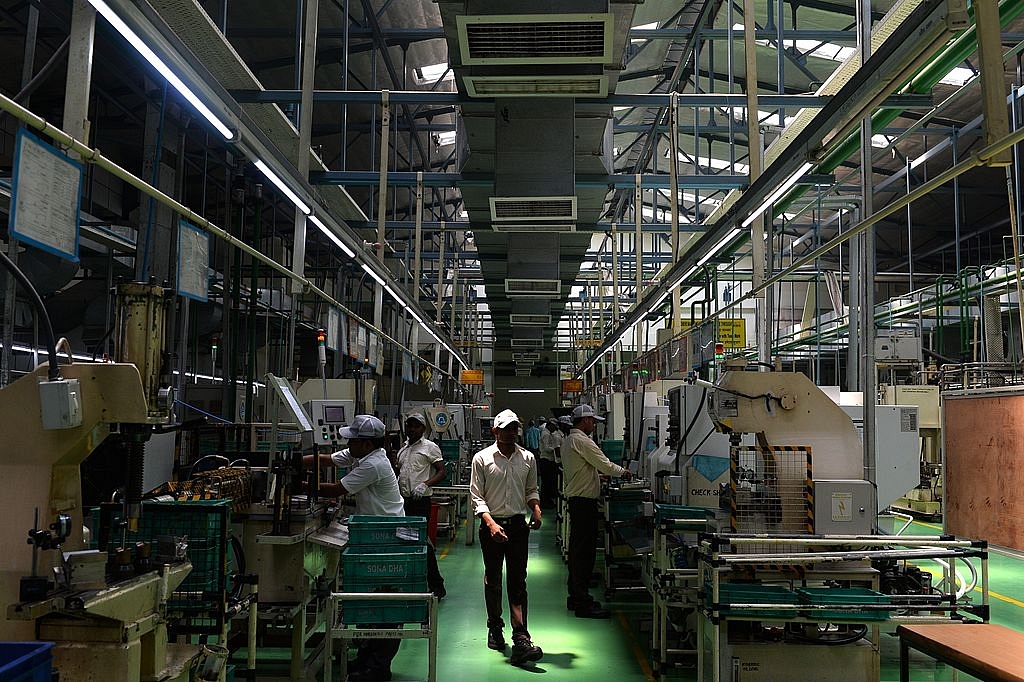Business
Why Delhi Has Overtaken Mumbai As India’s Commercial Capital
- Why did Delhi become the biggest city by GDP, overtaking Mumbai?
- There could be two reasons: one is demographic; the other is the slower-than-expected dismantling of the licence-permit raj, especially during the UPA years.

Workers manage machines at a factory of Sona Koyo Steering Systems in Dharuhera some 80kms south of New Delhi. Photo credit: Chandan Khanna/AFP/GettyImages
A recent report by global advisory firm Oxford Economics estimates that Delhi has overtaken Mumbai as India’s commercial capital, with its gross domestic product (GDP) in purchasing power parity (PPP) terms rising to $370 billion, pipping Mumbai with $368 billion.
PPP is measured by working out what a US dollar will buy in India, and then adjusting the value of the dollar downwards to reflect the rupee’s greater purchasing power locally. The PPP dollar was calculated at Rs 15.50 in 2012.
Delhi, in the Oxford Economics list, comprises the extended urban agglomeration of the National Capital Region, Gurgaon, Faridabad, Noida and Ghaziabad, while Mumbai means the Mumbai Metropolitan Region, Navi Mumbai, Thane, Vasai-Virar, Bhiwandi and Panvel.
Why did Delhi become the biggest city by GDP, overtaking Mumbai?
There could be two reasons: one is demographic; the other is the slower-than-expected dismantling of the licence-permit raj, especially during the UPA years.
The demographic reason is simple: Delhi is close to the high-population states of Uttar Pradesh, Rajasthan and Madhya Pradesh. And so in-migration towards Delhi and the extended National Capital Region (NCR) is relatively high compared to Mumbai. Some 70 per cent of Mumbai’s migrants are from within Maharashtra, whereas nearly half of Delhi’s migrants come from UP.
The 2011 census shows that both Delhi and Mumbai witnessed a slowdown in population growth, but while the NCR’s population grew by 40 per cent, the Mumbai agglomeration rose by just about 20 per cent. In 2011, the island city of Mumbai saw a drop of 5.75 per cent in population even though the suburbs grew at 8 per cent. The real growth in the Mumbai agglomeration has been in Thane, Navi Mumbai and Vasai-Virar.
Demography is a key determinant of GDP growth, and Mumbai’s changing demography and slower rate of population growth would automatically have impacted its GDP. Moreover, unlike Delhi, which has many clusters of industry around it, Mumbai is losing its manufacturing base. Its growth is only in financial and other services. Jobs are probably growing slower in Mumbai than in Delhi.
But the second reason can only be speculated upon. As the policy-making capital of India, Delhi wields power like Mumbai never can. After 1991, it was believed the businessmen would require to be less in Delhi than before, but the UPA years showed that managing Delhi is key to obtaining policy favours, as evidenced in the 2G, Coalgate and Commonwealth Games scams.
Anecdotally, given the sheer number of fixers and lobbyists in Delhi’s corridors of power before Modi banished them, one can assume that corruption and black money must have been a notch higher in Delhi than in Mumbai. This money would have been a key driver of growth and wealth-building in the entire NCR region. The rest of the country would have bribed Delhi to get its work done. This black income is likely to have been a big driver of Delhi’s growth.
In contrast, bribery in Mumbai would be focused on influencing state-level policies. Not much scope for enormous rent-seeking behaviour here.
If this hypothesis is right, that black money and corruption had a much greater role to play in Delhi’s growth than in Mumbai, it follows that once corruption in Delhi comes down, its growth may also slow down. It does not, however, follow that Mumbai will grow faster, for it now has many cities competing with it.
One thing is certain: in a rapidly federating country, Delhi will have less chance of generating illegal rent incomes than before. Delhi’s best years are probably over.
Introducing ElectionsHQ + 50 Ground Reports Project
The 2024 elections might seem easy to guess, but there are some important questions that shouldn't be missed.
Do freebies still sway voters? Do people prioritise infrastructure when voting? How will Punjab vote?
The answers to these questions provide great insights into where we, as a country, are headed in the years to come.
Swarajya is starting a project with an aim to do 50 solid ground stories and a smart commentary service on WhatsApp, a one-of-a-kind. We'd love your support during this election season.
Click below to contribute.
Latest